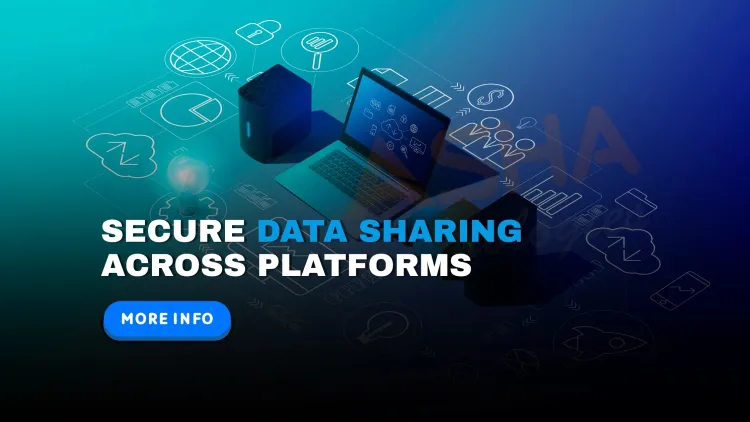How to Securely Share Data Across Platforms ? Encryption, Best Practices, and Tools
Discover how to securely share data across platforms using encryption, access control, and trusted protocols. Learn best practices for cross-platform data sharing in cloud, mobile, and enterprise environments.

Table of Contents
- Why Secure Cross-Platform Data Sharing Matters
- Common Scenarios That Require Secure Data Sharing
- Key Technologies and Protocols for Secure Sharing
- Best Practices for Secure Cross-Platform Data Sharing
- Real-World Use Cases
- Risks of Poor Cross-Platform Data Security
- Conclusion
- Frequently Asked Questions (FAQs)
In today’s interconnected digital ecosystem, data flows freely between devices, apps, and cloud environments. Whether it's sharing medical records between hospitals, syncing files between devices, or collaborating across company departments, secure data sharing across platforms has become vital. But with that convenience comes a serious challenge: How do you ensure that sensitive information remains safe, no matter where it travels?
This blog explores the methods, technologies, and best practices used to protect data during cross-platform sharing—whether it’s across different operating systems, cloud providers, or enterprise systems.
Why Secure Cross-Platform Data Sharing Matters
When data is shared across platforms—such as Windows to macOS, Android to iOS, or private cloud to public cloud—it becomes vulnerable to a variety of threats:
-
Interception during transmission
-
Data leaks from incompatible security policies
-
Unsecured APIs
-
Inconsistent encryption standards
This is especially critical in sectors like healthcare, finance, and government, where compliance with GDPR, HIPAA, or PCI DSS is mandatory.
Common Scenarios That Require Secure Data Sharing
-
Syncing data between mobile apps and cloud storage
-
Integrating systems via APIs across cloud platforms (e.g., AWS ↔ Azure)
-
Sharing files between different departments using different OS or security tools
-
Remote work scenarios involving collaboration between contractors and internal staff
-
Data migration from on-premises servers to cloud-based services
Key Technologies and Protocols for Secure Sharing
1. End-to-End Encryption (E2EE)
Encrypts data at the source and decrypts only at the destination, ensuring no one in-between—including service providers—can access the contents.
2. TLS (Transport Layer Security)
Widely used for securing web traffic, emails, and app communications. Always ensure HTTPS is used for file-sharing tools and API communication.
3. OAuth 2.0 and OpenID Connect
Allow for secure, token-based authorization across systems and platforms without exposing user credentials.
4. Secure File Transfer Protocols
-
SFTP (SSH File Transfer Protocol)
-
FTPS (FTP Secure)
Used to transfer files securely over the internet or internal networks.
5. Zero Trust Architecture (ZTA)
A security model that assumes no implicit trust—every data request must be authenticated, authorized, and encrypted.
Best Practices for Secure Cross-Platform Data Sharing
✅ Use Encrypted File Sharing Services
Choose services like Tresorit, OneDrive with encryption, or Google Workspace with access controls enabled.
✅ Implement Role-Based Access Control (RBAC)
Limit access to data based on user roles, ensuring employees only access data relevant to their job.
✅ Monitor APIs and Data Flows
Use API gateways, encryption, and monitoring tools to track how data moves between services.
✅ Use Digital Rights Management (DRM)
Control how shared data can be used, copied, or distributed once it’s accessed.
✅ Avoid Public Wi-Fi or Use VPN
Sensitive data transmission over unsecured networks can be intercepted. VPNs with strong encryption help reduce this risk.
✅ Keep Systems and Apps Updated
Many exploits target outdated software with known vulnerabilities. Patch regularly to avoid these weaknesses.
Real-World Use Cases
| Industry | Use Case | Solution Used |
|---|---|---|
| Healthcare | Sharing patient records between hospitals | HIPAA-compliant EHR with TLS & encryption |
| Banking | Data transfer between internal apps and external regulators | Encrypted APIs with OAuth 2.0 |
| Remote Work | File sharing between employee laptops and cloud storage | Zero Trust VPN, RBAC, and OneDrive encryption |
| Retail | Sharing customer data from PoS to cloud analytics | TLS, secure cloud storage, and audit logs |
Risks of Poor Cross-Platform Data Security
-
Man-in-the-middle attacks
-
Unauthorized access to APIs or storage buckets
-
Data breaches through third-party integrations
-
Loss of reputation and regulatory fines
Conclusion
Data sharing is inevitable in today’s collaborative environment—but security should never be an afterthought. Whether you're a small business sharing project files or an enterprise syncing massive datasets across clouds, implementing end-to-end encryption, strong access control, and trusted protocols can prevent costly breaches and ensure compliance.
If your organization values its data (and reputation), then secure cross-platform data sharing isn't optional—it's essential.
FAQ
What is secure data sharing?
Secure data sharing refers to the process of transferring data between users, systems, or platforms while protecting it from unauthorized access, tampering, or leaks using encryption, authentication, and access controls.
Why is secure data sharing important?
It ensures the confidentiality, integrity, and availability of sensitive data, prevents data breaches, and helps organizations comply with regulations like GDPR and HIPAA.
What are the main threats in data sharing?
Common threats include man-in-the-middle attacks, unauthorized access, data interception, insecure APIs, and misconfigurations.
How does end-to-end encryption help in data sharing?
It ensures that only the sender and the intended recipient can read the data, making it inaccessible to intermediaries or attackers.
What is the best protocol for secure file transfer?
SFTP (SSH File Transfer Protocol) and FTPS (FTP Secure) are widely considered secure for transferring files.
Can I securely share data over email?
Yes, but only if end-to-end encryption is used. Otherwise, email is generally not considered secure for sensitive data.
What is the difference between SFTP and FTPS?
SFTP uses SSH for encryption, while FTPS uses SSL/TLS. Both are secure, but SFTP is generally easier to configure through firewalls.
How does OAuth 2.0 contribute to secure data sharing?
OAuth 2.0 enables secure, token-based authentication and authorization between applications without exposing user credentials.
Is it safe to share data using cloud storage services?
Yes, if the service offers encryption, access control, and complies with data protection regulations.
What is Zero Trust architecture in data sharing?
Zero Trust assumes no user or system is trusted by default; it requires verification for every access request, ensuring safer sharing.
How do I secure APIs when sharing data between platforms?
Use authentication (like API keys or OAuth), TLS encryption, rate limiting, and input validation to secure APIs.
Which file-sharing tools support encryption?
Services like Tresorit, Sync.com, Google Drive (with settings), and OneDrive offer encryption for secure sharing.
How can I securely share files on public Wi-Fi?
Use a VPN with strong encryption and avoid accessing sensitive data unless absolutely necessary.
Are messaging apps like WhatsApp secure for sharing documents?
Yes, WhatsApp uses Signal Protocol for end-to-end encryption, but it's still recommended to avoid sending highly sensitive documents.
How do role-based access controls help?
RBAC ensures users only access data necessary for their role, reducing the risk of internal data exposure.
What is DRM and how does it help in data sharing?
Digital Rights Management (DRM) restricts how files can be used or shared after access, preventing misuse.
How do I share large encrypted files?
You can use tools like VeraCrypt, 7-Zip with AES encryption, or cloud storage with built-in encryption for large file sharing.
Is it necessary to encrypt data at rest and in transit?
Yes. Encrypting both protects against threats during transfer (transit) and after storage (at rest).
What are examples of secure data sharing in healthcare?
Hospitals sharing EHRs via HIPAA-compliant systems that use TLS and encrypted databases.
Can you share data securely across different operating systems?
Yes, as long as compatible encryption methods and protocols are used (e.g., SFTP, cloud services with access control).
What is a secure API gateway?
It manages, secures, and monitors data flows between platforms, ensuring data sharing occurs safely and efficiently.
What role does auditing play in secure data sharing?
Audit logs track who accessed or shared data, which helps detect and respond to potential breaches.
How often should I update file-sharing apps for security?
Always keep apps and systems updated to protect against known vulnerabilities and exploits.
Are collaboration platforms like Microsoft Teams secure for sharing?
Yes, when configured properly with encrypted storage, MFA, and access controls.
What’s the difference between secure and insecure data sharing?
Secure sharing uses encryption, authentication, and access controls. Insecure sharing lacks these protections and is vulnerable to threats.
Can VPNs ensure secure data sharing?
VPNs encrypt the connection between devices, reducing the risk of data interception, especially on untrusted networks.
How does GDPR impact cross-platform data sharing?
GDPR requires data to be securely processed and transferred, with proper user consent and protection against unauthorized access.
What’s the safest way to share passwords or credentials?
Use password managers with encrypted sharing capabilities like Bitwarden or 1Password.
Can I control who accesses the data I share?
Yes, using tools with access controls, time-limited links, and view/download restrictions.
How do organizations ensure secure collaboration with third parties?
Through contracts (e.g., data sharing agreements), encrypted tools, regular audits, and access control policies.














![Top 10 Ethical Hackers in the World [2025]](https://www.webasha.com/blog/uploads/images/202408/image_100x75_66c2f983c207b.webp)








